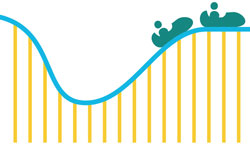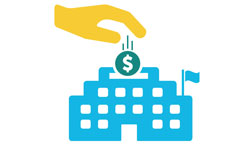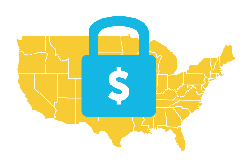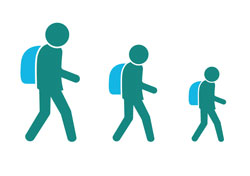For sixteen years, the State Higher Education Executive Officers
Association (SHEEO) has produced the annual State Higher Education
Finance (SHEF) report to broaden understanding and enable analysis of
state-level and national funding and enrollment trends over time. The
SHEF report provides the earliest possible review of state funding for
higher education for the most recently completed fiscal year. SHEF also
includes a robust data set for fiscal years 1980-2019 with detailed data
on state and local funding, tuition revenue, and enrollment, with
interactive data visualization materials.
An early look at the state support for 2019 is available in the Grapevine data compilation.
In late 2018, SHEEO began a two-year grant-funded project to improve
the SHEF report. This project is funded by the Bill & Melinda Gates
Foundation.
The
2018 SHEF report examines the trends, context, and consequences of state higher education funding decisions.
Explore the Report
Sources and Uses of Revenue
This
section provides data and analysis of the sources and uses of state and
local government support for higher education, focusing on the most
recent five-year trend (2013-2018), during which most states largely
recovered from the Great Recession.
These funding amounts are not adjusted for inflation or enrollment.
Sources
- In unadjusted terms, state and local government support grew 20.3
percent from 2013, reaching an all-time high of $99 billion in 2018.
State funding grew 2 percent in the last year, from $86.5 to $88.2
billion in 2018.
- State tax appropriations remained the largest source of funds, totaling $83.9 billion (84.7 percent of all state support).
- Local support in 29 states, which typically funds community
colleges, increased 2.7 percent to $10.8 billion in the last year,
totaling 10.9 percent of funds.
- Non-tax appropriations, mostly from state lotteries, continued to
grow and exceeded $3.5 billion (3.6 percent of all funds) in 2018.
Uses
- General operating expenses at public institutions increased 23
percent in the last five years, reaching $77.7 billion, or 78.4 percent
of the total state and local government funding.
- $10.3 billion (10.4 percent) went to special purpose appropriations
for research, agricultural extension programs, and medical education.
- $10.6 billion (10.7 percent) was allocated to state-funded student
financial aid programs. Over three-quarters of this aid went to students
attending public institutions within a state.
- Funding for operations at independent institutions has increased
22.5 percent in the last five years, while funding for non-credit and
continuing education programs decreased 12.2 percent. These funds
account for less than 1 percent of state and local support.
Figures and Tables
National Trends in Enrollment and Revenue
This section highlights the composite trends in higher education
funding across all 50 states. Data are adjusted for inflation and
presented on a per full-time equivalent enrollment (FTE) basis.
General operations at public institutions of higher education are
funded from both state and local support and tuition revenue. In the
last 25 years, student FTE increased from 8.2 million to 10.9 million,
while educational appropriations per FTE declined 4.2 percent, and net
tuition revenue per FTE increased 85.6 percent in constant dollars.
- Full-Time Equivalent Enrollment (FTE). In 2018,
there were 10.9 million FTE enrolled students. Recent enrollment
declines have slowed, and FTE decreased less than 1 percent over the
last two years.
- Educational Appropriations. Despite five years of
small increases and steady appropriations in the last year,
appropriations remain below historic levels after four straight years of
declines during the Great Recession. Ten years after the start of the
Great Recession, state funding for higher education has only halfway
recovered and states fund about $1,000 less per FTE than in 2008.
- State Public Financial Aid. In the last year, state
public aid increased 8.7 percent to $752 per FTE. During the worst
years of the Great Recession, states protected their investments in
financial aid, and aid increased while the rest of appropriations
dropped.
- Net Tuition Revenue. Net tuition revenue was
essentially flat in the last year, but has increased 38.7 percent since
before the Great Recession. Tuition revenue is affected by changes in
student population, enrollment mix, and rate increases.
- Student Share. Student share grew rapidly during
the Great Recession and has since declined slightly. In 2018, student
share was over 10 percentage points above 2008 levels. In over half of
all states, tuition revenue comprises more than 50 percent of total
revenue.
- Total Educational Revenue. After dropping
significantly during the Great Recession, total educational revenue
recovered in 2015. Nationally, increases in net tuition revenue have
more than offset reductions in state and local funding per student.
However, there is wide variation across the country, and reductions have
not been offset at all institutions or in all states.
Figures and Tables
Interstate Comparisons
This section expands upon the national metrics to closely examine
interstate differences across the SHEF metrics of higher education
financing. Data are adjusted for inflation, enrollment mix, and cost of
living, and are presented on a per full-time equivalent enrollment (FTE)
basis. See the technical documentation to learn more about these
adjustments.
This section illustrates the variability across states and over time
concerning higher education enrollment growth, total state and local
appropriations, the amount and proportion of tuition-derived revenue,
and total revenue available for public education.
- Full-Time Equivalent Enrollment (FTE). While
enrollment was flat at the national level in the last year, it actually
declined in 35 states. In the last five years, the sharp enrollment
increases seen during the Great Recession have steadily declined as most
state economies recovered. However, enrollment in 38 states remains
above pre-recession levels.
- Educational Appropriations. Like enrollment, flat
national educational appropriations mask differences among states.
Educational appropriations per FTE are more than $1,000 above the U.S.
average in nine states, and are more than $1,000 below it in 23 states.
While 22 states saw declines in educational appropriations per FTE in
the last year, the year-over-year change was less than 1 percent in 14
states. Only a handful of states that faced appropriations declines
during the Great Recession have returned to their pre-recession funding
levels.
- Net Tuition Revenue. Tuition revenue per FTE
increased in just over half of all states and Washington, D.C. Net
tuition has increased beyond inflation in every state since before the
Great Recession, and has increased by more than 50 percent in 14 states.
States vary widely in their student share, but every state has seen
increases. In 2018, public higher education is more dependent on tuition
revenue than educational appropriations in over half of all states.
- Total Educational Revenue. States vary widely in
their total educational revenue; only 16 states are within $1,000 of the
U.S. average in total revenue per FTE. Twenty-nine states saw increases
in total educational revenue per FTE in the last year. However, changes
to total revenue were less than 1 percent in 21 states. Sixteen states
are still below their pre-recession levels of total educational revenue.
Figures and Tables
State Revenue, Taxes and Funding effort
This section is intended to provide additional context behind the
varied levels of state funding for higher education across the states.
To do this, SHEEO compares three indicators of a state’s effort and
capacity to fund higher education: state support per capita, state
support per thousand dollars of personal income, and state support of
higher education as a percentage of total state revenues.
At the aggregate level, state tax capacity has rebounded from the
Great Recession, but state effort to fund higher education has not
recovered on any of the measures below. These data are pulled from
publicly available sources, and are less recent than the SHEF data. All
comparisons are between 2008 and 2016.
- State Support per Capita. States with larger
populations should, theoretically, have greater fiscal capacity to
direct resources toward higher education. On average, states provided
$298 in higher education support per capita. States range between $93 in
New Hampshire to $714 in Wyoming. Higher education support per capita
was higher in eight states in 2016 than in 2008.
- State Support per $1,000 of Personal Income. This
measure provides context about the scale of support for higher education
in relation to a state’s available tax base. The U.S. average was $5.80
of support per $1,000 of personal income, and states again ranged from
New Hampshire ($1.60) to Wyoming ($12.40). State support per $1,000 of
personal income increased in only two states between 2008 and 2016.
- Percent of State Revenues Allocated to Higher Education. States
provide different proportions of their available tax and non-tax
revenues to higher education. Comparing total available state revenues
contextualizes a state’s ability to fund higher education. On average,
states allocate 5.8 percent of available revenues to higher education.
Twenty states are within 1 percent of the U.S. average. Only seven
states allocated a greater portion of revenue to higher education in
2016 than before the Great Recession.
Figures and Tables
Case Studies
- Recovery from Great Recession:
This case study provides an analysis of how well states have recovered
from the Great Recession. We consider the depth of cuts in state
funding, recovery of total educational revenues and the sources of that
recovery, and changes in state financial aid.
- Fiscal Challenges in Illinois: Higher
education finance data for Illinois continues to be an outlier in the
2018 SHEF Report. This case study provides context behind the
significant increases in Illinois’ state support and explains how the
SHEF data handle Illinois’ lack of a budget in 2016 and 2017.
- State Budget Drivers: Higher
education spending has struggled to recover to pre-recession levels.
This case study explores some of the revenue and expenditure drivers
that have led to this slow recovery.
Key findings for fiscal year 2018 include:
 HIGHER EDUCATION FUNDING IS STABILIZING:
HIGHER EDUCATION FUNDING IS STABILIZING: Nationally,
state and local per student support for higher education increased at
the rate of inflation from 2017 to 2018. This minimal growth follows a
five-year period of annual funding increases greater than 2 percent,
indicating that state appropriations have stabilized, albeit at a much
lower level.
 STUDENT SHARE IS THE NEW NORM:
For the first time since the Great Recession, net tuition revenue
remained flat in 2018, indicating that the growing reliance on net
tuition as a revenue source—the student share—might be leveling. While
tuition revenue measures more than just rate increases, flat tuition
revenue may be a sign of the impacts of increasing attention on college
affordability
STUDENT SHARE IS THE NEW NORM:
For the first time since the Great Recession, net tuition revenue
remained flat in 2018, indicating that the growing reliance on net
tuition as a revenue source—the student share—might be leveling. While
tuition revenue measures more than just rate increases, flat tuition
revenue may be a sign of the impacts of increasing attention on college
affordability
 GOOD NEWS FOR STATE FINANCIAL AID:
GOOD NEWS FOR STATE FINANCIAL AID: In 2018, state
financial aid saw the largest increase since the Great Recession.
Financial aid now represents nearly 10 percent of all appropriations,
and encouragingly, evidence shows that states largely protect this
source of support during economic downturns.
 ENROLLMENT DECLINES ARE SLOWING DOWN:
ENROLLMENT DECLINES ARE SLOWING DOWN:




No comments:
Post a Comment